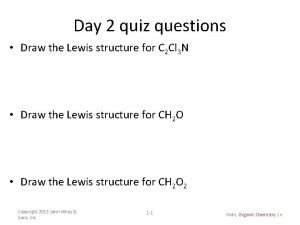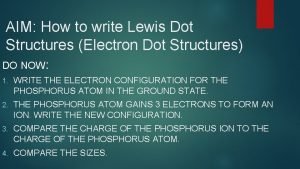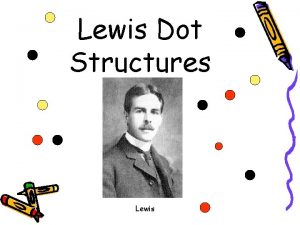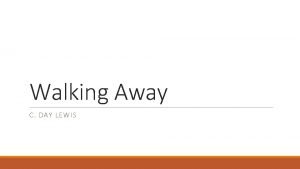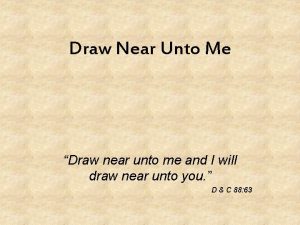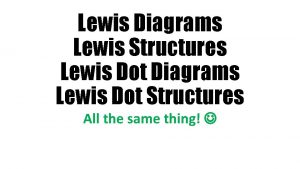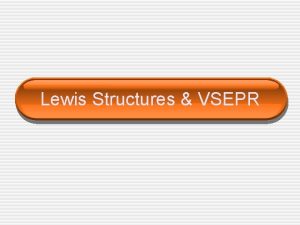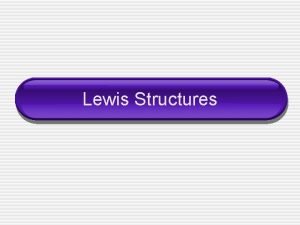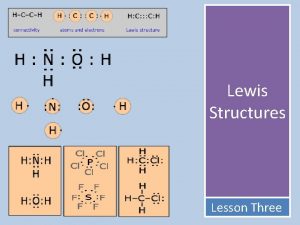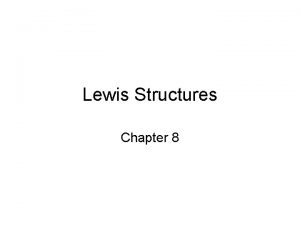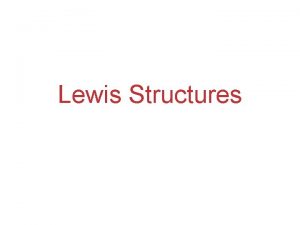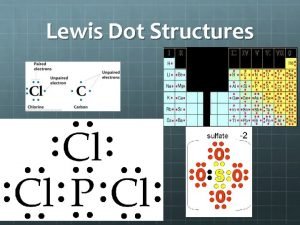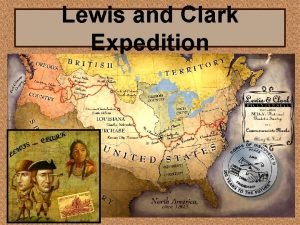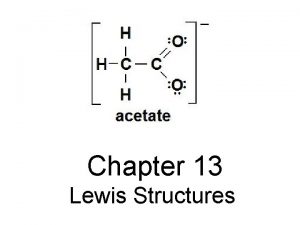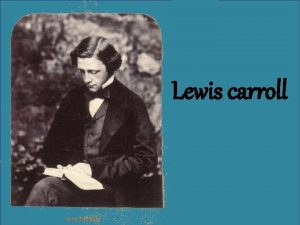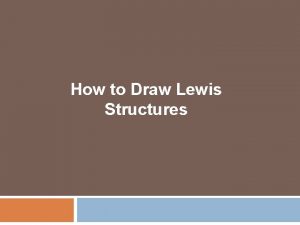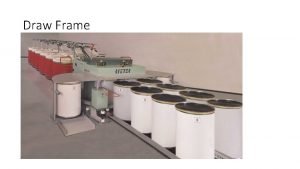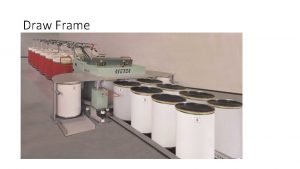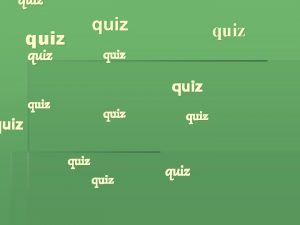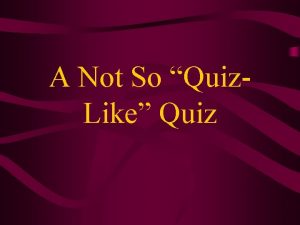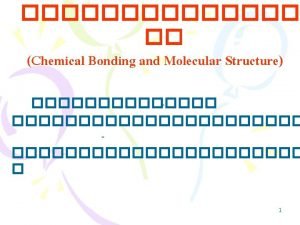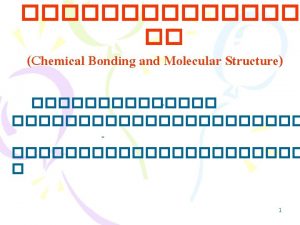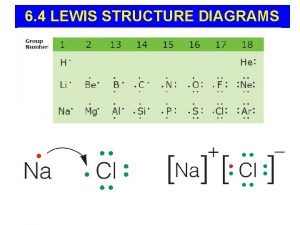Day 2 quiz questions Draw the Lewis structure



































































- Slides: 67

Day 2 quiz questions • Draw the Lewis structure for C 2 Cl 3 N • Draw the Lewis structure for CH 2 O 2 Copyright 2012 John Wiley & Sons, Inc. 1 -1 Klein, Organic Chemistry 1 e

Day 2 quiz questions • Draw in all formal charges for the structures below. Copyright 2012 John Wiley & Sons, Inc. 1 -2 Klein, Organic Chemistry 1 e

Day 2 quiz questions • How many nodes are in the 3 s subshell? • How many nodes are in a typical sigma antibonding MO? • How many nodes are in a typical sp 3 orbital? • How many nodes are in a typical pi bonding MO? • How many nodes are in a typical pi antibonding MO Copyright 2012 John Wiley & Sons, Inc. 1 -3 Klein, Organic Chemistry 1 e

Day 2 quiz questions • Analyze the geometry for each central atom in each molecule below and draw in an appropriate dipole moment for each of the following molecules. Copyright 2012 John Wiley & Sons, Inc. 1 -4 Klein, Organic Chemistry 1 e

Day 3 quiz questions • Describe all of the intermolecular attractions possible for each the following molecules. Copyright 2012 John Wiley & Sons, Inc. 1 -5 Klein, Organic Chemistry 1 e

Day 3 quiz questions • How many carbon and hydrogen atoms are in the following molecule? Copyright 2012 John Wiley & Sons, Inc. 2 -6 Klein, Organic Chemistry 1 e

Day 3 quiz questions • Draw the bond-line structures from the following formulas: • C(CH 3)3 CN • Cl 2 CH(CH 2)5 CO 2 H • CH 3 CHBr. CH(NH 2)C(CH 3)3 Copyright 2012 John Wiley & Sons, Inc. 2 -7 Klein, Organic Chemistry 1 e

Day 4 quiz questions • Fill in any necessary formal charge on the molecule below Copyright 2012 John Wiley & Sons, Inc. 2 -8 Klein, Organic Chemistry 1 e

Day 4 quiz questions • Fill in any necessary lone pairs in the structure below Copyright 2012 John Wiley & Sons, Inc. 2 -9 Klein, Organic Chemistry 1 e

Day 4 quiz questions • Show all of the resonance contributors for the following molecule and show the curved arrows necessary to get from one contributor to the next. Copyright 2012 John Wiley & Sons, Inc. 2 -10 Klein, Organic Chemistry 1 e

Day 5 quiz questions • Draw the appropriate resonance hybrid for the structure below. Copyright 2012 John Wiley & Sons, Inc. 2 -11 Klein, Organic Chemistry 1 e

Day 5 quiz questions • Provide products and curved arrows for the following acid base reaction Copyright 2012 John Wiley & Sons, Inc. 3 -12 Klein, Organic Chemistry 1 e

Day 5 quiz questions • For a base with an especially large value for Kb. Will its conjugate acid have a relatively low or high p. Ka? Explain why using the relative p. Ka values to illustrate. Copyright 2012 John Wiley & Sons, Inc. 3 -13 Klein, Organic Chemistry 1 e

Day 5 quiz questions • Which side of the following generic reaction will be favored, and what will the ratio of products/reactants be once equilibrium is reached? HA + B: HB + A: p. Ka = 5 8 Copyright 2012 John Wiley & Sons, Inc. 3 -14 Klein, Organic Chemistry 1 e

Day 6 quiz questions • Rank the following bases in order of increasing strength and rank their conjugates in order of increasing p. Ka. Copyright 2012 John Wiley & Sons, Inc. 3 -15 Klein, Organic Chemistry 1 e

Day 8 quiz questions • Name the following molecule • Draw the bond-line representation for 1, 2, 6, 7 tetrabromo-4 -(1, 2 -dichloroethyl)nonane. Copyright 2012 John Wiley & Sons, Inc. 4 -16 Klein, Organic Chemistry 1 e

Day 8 quiz questions • Determine whether the following pair are constitutional isomers, identical, or no relationship Copyright 2012 John Wiley & Sons, Inc. 4 -17 Klein, Organic Chemistry 1 e

Day 9 quiz questions • Describe in how heat of combustion is used to determine the relative stabilities of hydrocarbons with the same formula. Copyright 2012 John Wiley & Sons, Inc. 4 -18 Klein, Organic Chemistry 1 e

Day 9 quiz questions • Given the following Newman Projection, name the molecule, draw its bond-line structure, and draw a Newman projection showing its highest energy conformation illustrating the torsional strain. Copyright 2012 John Wiley & Sons, Inc. 4 -19 Klein, Organic Chemistry 1 e

Day 10 quiz questions • Draw the highest and lowest energy chair conformations for the molecule given Copyright 2012 John Wiley & Sons, Inc. 4 -20 Klein, Organic Chemistry 1 e

Day 10 quiz questions • Draw a pair of constitutional isomers. EXPLAIN Copyright 2012 John Wiley & Sons, Inc. 5 -21 Klein, Organic Chemistry 1 e

Day 10 quiz questions • Draw a pair of cis-trans isomers. EXPLAIN Copyright 2012 John Wiley & Sons, Inc. 5 -22 Klein, Organic Chemistry 1 e

Day 10 quiz questions • Draw a pair of enantiomers. Explain Copyright 2012 John Wiley & Sons, Inc. 5 -23 Klein, Organic Chemistry 1 e

Day 10 quiz questions • Draw a molecule with 3 chiral centers. Copyright 2012 John Wiley & Sons, Inc. 5 -24 Klein, Organic Chemistry 1 e

Day 10 quiz questions • For the molecule below, label each chiral center. Copyright 2012 John Wiley & Sons, Inc. 5 -25 Klein, Organic Chemistry 1 e

Day 10 quiz questions • Designate each chirality center below as either R or S. Copyright 2012 John Wiley & Sons, Inc. 5 -26 Klein, Organic Chemistry 1 e

Day 11 quiz questions • Draw a pair of diastereomers that are not cis-trans isomers. EXPLAIN Copyright 2012 John Wiley & Sons, Inc. 5 -27 Klein, Organic Chemistry 1 e

Day 11 quiz questions • If pure R enantiomer has a specific rotation of +33 degrees, what will the rotation be when you have a mixture with a R/S ratio = 44/56? Copyright 2012 John Wiley & Sons, Inc. 5 -28 Klein, Organic Chemistry 1 e

Day 11 quiz questions • Determine the relationship between the pairs below. Copyright 2012 John Wiley & Sons, Inc. 5 -29 Klein, Organic Chemistry 1 e

Day 11 quiz questions • Consider electrocyclic ring opening • In the reaction, 1 signma bond is converted into 1 pi bond. Predict the sign (+ or -) for ΔHsys • Predict the sign (+ or -) for ΔHsurr Copyright 2012 John Wiley & Sons, Inc. Klein, Organic Chemistry 1 e 6 -30

Day 12 quiz questions • Consider electrocyclic ring opening • • Predict the sign (+ or -) for ΔSsys Predict the sign (+ or -) for ΔSsurr Predict the sign (+ or -) for ΔGsys Will the reaction become more or less spontaneous if performed at a higher termperature? Copyright 2012 John Wiley & Sons, Inc. Klein, Organic Chemistry 1 e 6 -31

Day 12 quiz questions • Explain why an equilibrium mixture is always lower in free energy than pure products or pure reactants. Copyright 2012 John Wiley & Sons, Inc. Klein, Organic Chemistry 1 e 6 -32

Day 12 quiz questions • Reactants A and B can react by two different pathways. Pathway 1 is thermodynamically favored, and pathway 2 is kinetically favored. Draw a reaction coordinate diagraph to illustrate the relative energies and explain which pathway will be favored at low temperatures versus higher temperatures. Copyright 2012 John Wiley & Sons, Inc. Klein, Organic Chemistry 1 e 6 -33

Day 13 quiz questions • Label all of the nucleophilic and electrophilic sites on the following molecules Copyright 2012 John Wiley & Sons, Inc. Klein, Organic Chemistry 1 e 6 -34

Day 13 quiz questions • Draw a mechanism for a generic nucleophilic attack followed by a proton transfer. • Draw a mechanism for a generic loss of leaving group followed by a carbocation rearrangement. Copyright 2012 John Wiley & Sons, Inc. Klein, Organic Chemistry 1 e 6 -35

Day 13 quiz questions • For each of the mechanistic steps below, identify what is incorrect about it. Copyright 2012 John Wiley & Sons, Inc. Klein, Organic Chemistry 1 e 6 -36

Day 15 quiz questions • Give reasonable names for the following molecules • Label each halide as primary, secondary, or tertiary Copyright 2012 John Wiley & Sons, Inc. Klein, Organic Chemistry 1 e 7 -37

Day 15 quiz questions • Give the best set of reaction conditions to promote SN 2 for the following substrate. • Describe experiments that could be done to support the proposed mechanism Copyright 2012 John Wiley & Sons, Inc. Klein, Organic Chemistry 1 e 7 -38

Day 15 quiz questions • Give the best set of reaction conditions to promote SN 1 for the following substrate. • Describe experiments that could be done to support the proposed mechanism Copyright 2012 John Wiley & Sons, Inc. Klein, Organic Chemistry 1 e 7 -39

Day 16 quiz questions • Propose reaction conditions and give a complete mechanism for the following substitution reaction Copyright 2012 John Wiley & Sons, Inc. Klein, Organic Chemistry 1 e 7 -40

Day 16 quiz questions • Give a complete mechanism for the following substitution reaction Copyright 2012 John Wiley & Sons, Inc. Klein, Organic Chemistry 1 e 7 -41

Day 17 quiz questions • Name the following molecules Copyright 2012 John Wiley & Sons, Inc. Klein, Organic Chemistry 1 e 8 -42

Day 17 quiz questions • Label the molecules below as either cis or trans and either E or Z where appropriate Copyright 2012 John Wiley & Sons, Inc. Klein, Organic Chemistry 1 e 8 -43

Day 17 quiz questions • For the substrate, give both the kinetically favored E 2 product and thermodynamically favored E 2 product. Explain what conditions can be used to favor each. Copyright 2012 John Wiley & Sons, Inc. Klein, Organic Chemistry 1 e 8 -44

Day 17 quiz questions • Since tertiary substrates react more readily than secondary or primary in both E 1 and E 2 mechanisms, what factor(s) usually controls which mechanism will dominate and why? Copyright 2012 John Wiley & Sons, Inc. Klein, Organic Chemistry 1 e 8 -45

Day 18 quiz questions • Consider both regioselestivity and stereoselectivity to predict the major product for the elimination below Copyright 2012 John Wiley & Sons, Inc. Klein, Organic Chemistry 1 e 8 -46

Day 18 quiz questions • Predict the major product if the alcohol below were treated with concentrated sulfuric acid. Be aware of the possible rearrangements. Copyright 2012 John Wiley & Sons, Inc. Klein, Organic Chemistry 1 e 8 -47

Day 19 quiz questions • Predict the major product for the following reactions considering competing substitution and elimination pathways. Copyright 2012 John Wiley & Sons, Inc. Klein, Organic Chemistry 1 e 8 -48

Day 19 quiz questions • Explain why a completely nonpolar bond will not give a stretching signal in the IR spectra. Would you expect to see a signal for C-H stretching for a nonpolar molecule? Why or why not? Copyright 2012 John Wiley & Sons, Inc. Klein, Organic Chemistry 1 e 15 -49

Day 20 quiz questions • Explain how IR might be used to qualitatively determine the degree of substitution when ammonia is treated with excess bromoethane. Copyright 2012 John Wiley & Sons, Inc. Klein, Organic Chemistry 1 e 15 -50

Day 20 quiz questions • How might you use EI GCMS to distinguish between constitutional isomers? Copyright 2012 John Wiley & Sons, Inc. Klein, Organic Chemistry 1 e 15 -51

Day 20 quiz questions • Explain how an experiment involving isotopic labeling might be used to explore the type of fragmentation that occurs in the MS analysis of organic compounds. Copyright 2012 John Wiley & Sons, Inc. Klein, Organic Chemistry 1 e 15 -52

Day 22 quiz questions • Explain why a deuterated solvent is used in NMR experiments rather than a protonated solvent. Is such a solvent necessary when analyzing 13 C NMR? Copyright 2012 John Wiley & Sons, Inc. Klein, Organic Chemistry 1 e 16 -53

Day 22 quiz questions • Identify all the groups of equivalent protons in the molecule below and explain WHY enantiotopic protons are equivalent while diastereotopic protons are not. Copyright 2012 John Wiley & Sons, Inc. Klein, Organic Chemistry 1 e 16 -54

Day 23 quiz questions • Predict the chemical shift, integration, and splitting patterns for all of the protons in the following molecule Copyright 2012 John Wiley & Sons, Inc. Klein, Organic Chemistry 1 e 16 -55

Day 24 quiz questions • Predict the number of signals and chemical shifts in the 13 C NMR spectrum and DEPT spectrum for the molecule below Copyright 2012 John Wiley & Sons, Inc. Klein, Organic Chemistry 1 e 16 -56

Day 24 quiz questions • If you want to favor addition rather than elimination, do you generally want a high or low temperature, and why? Copyright 2012 John Wiley & Sons, Inc. Klein, Organic Chemistry 1 e 9 -57

Day 24 quiz questions • Predict the major product for the addition reaction below. Be aware of possible rearrangements and stereochemical concerns. Copyright 2012 John Wiley & Sons, Inc. Klein, Organic Chemistry 1 e 9 -58

Day 24 quiz questions • How and why will the concentration of acid affect whether an acid catalyzed hydration will favor products or reactants at equilibrium? Copyright 2012 John Wiley & Sons, Inc. Klein, Organic Chemistry 1 e 9 -59

Day 25 quiz questions • Give an example reaction for Markovnikov hydration without the possibility of rearrangement. • Give an example reaction for syn anti. Markovnikov hydration. Copyright 2012 John Wiley & Sons, Inc. Klein, Organic Chemistry 1 e 9 -60

Day 25 quiz questions • Should a halogenation reaction be overall first or second order kinetics? Also, Explain why it gives anti addition rather than syn. Copyright 2012 John Wiley & Sons, Inc. Klein, Organic Chemistry 1 e 9 -61

Day 26 quiz questions • What reagents are necessary to achieve the following synthesis? Copyright 2012 John Wiley & Sons, Inc. Klein, Organic Chemistry 1 e 9 -62

Day 26 quiz questions • Name the molecule • Draw the structure of 2, 2 -dimethyl-6 -chloro-3 -heptyne Copyright 2012 John Wiley & Sons, Inc. Klein, Organic Chemistry 1 e 10 -63

Day 27 quiz questions • Give 2 sets of reagents that could be used to synthesize 1 -pentyne through the elimination a dihalide. Copyright 2012 John Wiley & Sons, Inc. Klein, Organic Chemistry 1 e 10 -64

Day 27 quiz questions • Give a set of reagents that could be used to synthesize cis-2 -pentene from an addition reaction. • Give a set of reagents that could be used to synthesize trans-2 -pentene from an addition reaction. Copyright 2012 John Wiley & Sons, Inc. Klein, Organic Chemistry 1 e 10 -65

Day 27 quiz questions • Give a set of reagents that could be used to synthesize a ketone from an addition reaction. • Give a set of reagents that could be used to synthesize an aldehyde from an addition reaction. Copyright 2012 John Wiley & Sons, Inc. Klein, Organic Chemistry 1 e 10 -66

Day 27 quiz questions • Determine necessary reagents to complete the synthesis below. Copyright 2012 John Wiley & Sons, Inc. Klein, Organic Chemistry 1 e 10 -67
 Day 1 day 2 day 3 day 4
Day 1 day 2 day 3 day 4 Day 1 day 2 day 817
Day 1 day 2 day 817 Draw the lewis structure for hcch (ethyne).
Draw the lewis structure for hcch (ethyne). Lewis structure quiz
Lewis structure quiz Groundhog day quiz questions
Groundhog day quiz questions Lewis dot structure cl
Lewis dot structure cl How to draw a lewis dot diagram for an element
How to draw a lewis dot diagram for an element Ps2-1 lewis structure
Ps2-1 lewis structure A hard frost
A hard frost Walking away c day lewis
Walking away c day lewis Draw unto me and i will
Draw unto me and i will How to draw use case diagram in draw.io
How to draw use case diagram in draw.io Schoolmax login
Schoolmax login Oceans apart day after day meaning
Oceans apart day after day meaning Day to day maintenance
Day to day maintenance As your room gets messier day by day, entropy is
As your room gets messier day by day, entropy is I don't know about tomorrow i just live from day to day
I don't know about tomorrow i just live from day to day Romeo and juliet act 3 timeline
Romeo and juliet act 3 timeline Growing day by day
Growing day by day Seed germination inhibitors examples
Seed germination inhibitors examples Conclusion of seed germination
Conclusion of seed germination Role of transpiration
Role of transpiration I live for jesus day after day
I live for jesus day after day Casting crowns one day
Casting crowns one day Day one day one noodle ss2
Day one day one noodle ss2 Day one day one noodles ss2
Day one day one noodles ss2 Hát kết hợp bộ gõ cơ thể
Hát kết hợp bộ gõ cơ thể Lp html
Lp html Bổ thể
Bổ thể Tỉ lệ cơ thể trẻ em
Tỉ lệ cơ thể trẻ em Chó sói
Chó sói Tư thế worm breton
Tư thế worm breton Chúa yêu trần thế alleluia
Chúa yêu trần thế alleluia Các môn thể thao bắt đầu bằng từ đua
Các môn thể thao bắt đầu bằng từ đua Thế nào là hệ số cao nhất
Thế nào là hệ số cao nhất Các châu lục và đại dương trên thế giới
Các châu lục và đại dương trên thế giới Cong thức tính động năng
Cong thức tính động năng Trời xanh đây là của chúng ta thể thơ
Trời xanh đây là của chúng ta thể thơ Mật thư tọa độ 5x5
Mật thư tọa độ 5x5 Phép trừ bù
Phép trừ bù độ dài liên kết
độ dài liên kết Các châu lục và đại dương trên thế giới
Các châu lục và đại dương trên thế giới Thơ thất ngôn tứ tuyệt đường luật
Thơ thất ngôn tứ tuyệt đường luật Quá trình desamine hóa có thể tạo ra
Quá trình desamine hóa có thể tạo ra Một số thể thơ truyền thống
Một số thể thơ truyền thống Cái miệng nó xinh thế chỉ nói điều hay thôi
Cái miệng nó xinh thế chỉ nói điều hay thôi Vẽ hình chiếu vuông góc của vật thể sau
Vẽ hình chiếu vuông góc của vật thể sau Nguyên nhân của sự mỏi cơ sinh 8
Nguyên nhân của sự mỏi cơ sinh 8 đặc điểm cơ thể của người tối cổ
đặc điểm cơ thể của người tối cổ V cc
V cc Vẽ hình chiếu đứng bằng cạnh của vật thể
Vẽ hình chiếu đứng bằng cạnh của vật thể Fecboak
Fecboak Thẻ vin
Thẻ vin đại từ thay thế
đại từ thay thế điện thế nghỉ
điện thế nghỉ Tư thế ngồi viết
Tư thế ngồi viết Diễn thế sinh thái là
Diễn thế sinh thái là Dạng đột biến một nhiễm là
Dạng đột biến một nhiễm là Số.nguyên tố
Số.nguyên tố Tư thế ngồi viết
Tư thế ngồi viết Lời thề hippocrates
Lời thề hippocrates Thiếu nhi thế giới liên hoan
Thiếu nhi thế giới liên hoan ưu thế lai là gì
ưu thế lai là gì Hổ đẻ mỗi lứa mấy con
Hổ đẻ mỗi lứa mấy con Khi nào hổ con có thể sống độc lập
Khi nào hổ con có thể sống độc lập Sơ đồ cơ thể người
Sơ đồ cơ thể người Từ ngữ thể hiện lòng nhân hậu
Từ ngữ thể hiện lòng nhân hậu Thế nào là mạng điện lắp đặt kiểu nổi
Thế nào là mạng điện lắp đặt kiểu nổi



